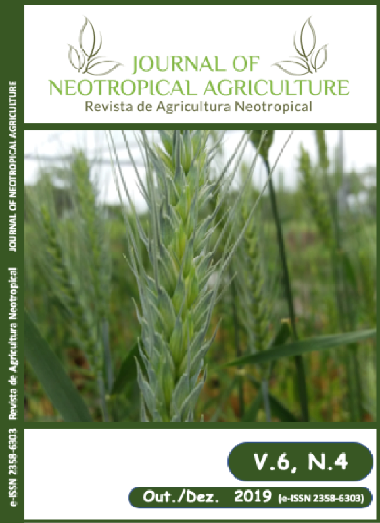HYDROCOOLING EFFICIENCY ON POSTHARVEST CONSERVATION AND QUALITY OF ARUGULA
DOI:
https://doi.org/10.32404/rean.v6i4.3457Abstract
Arugula is mainly cultivated by small producers, being a leafy vegetable susceptible to water loss and wilting after harvest, which may result in changes in appearance, texture, color (yellowing), and nutritional value of the product. Hydrocooling is a cooling method that stands out for being simple, practical and efficient. Its use is to reduce the temperature and respiratory rate of vegetables after harvesting by immersion in ice or cold water, so they can be packed and stored. This study was conducted to evaluate the hydrocooling efficiency when associated with the storage period in the postharvest shelf life of arugula leaves. Arugula leaves were subjected to ten days of storage, and measurements were taken at 0, 2, 4, 6, 8 and 10 days. The experimental design was completely randomized in a 3 × 6 factorial scheme, consisting of three hydrocooling treatments [control (without cooling), and hydrocooling at 0 °C and 10 °C] and for six storage periods (0, 2, 4, 6, 8 and 10 days) with three replicates. Fresh mass loss, soluble solids, titratable acidity, pH and subjective evaluation of product appearance were measured. Hydrocooling at 0 °C proved to be the most appropriate treatment when compared to control, as reported by the values of fresh mass loss, soluble solids, and titratable acidity. Hydrocooling to 0 °C slowed leaf water loss (lower respiratory rate) and resulted in better overall leaf appearance up to the sixth day of storage, thereby increasing shelf life of arugula leaves.
References
(I) Álvares, V.S., Ramos, P.A.S., Mapeli, A.M., Finger, F.L., 2010. Pré-resfriamento e embalagem na conservação de folhas de salsa. Brazilian Journal of Food Technology, 13(2), 107-111.
(II) Chitarra, M.I.F., Chitarra, A.B., 2005. Pós-colheita de frutos e hortaliças: fisiologia e manuseio, segunda ed. UFLA, Lavras.
(III) Feba, L.T., Mazzuchelli, E.H.L., Carvalho, P.R., Cacefo, V., 2017. Silício promove melhor conservação pós-colheita da alface. Colloquium Agrariae, 13, 189-195.
(IV) Ferreira, D.F., 2011. Sisvar: a computer statistical analysis system. Revista Ciência e Agrotecnologia, 35(6), 1039-1042.
(V) Finger, F.L., Álvares, V.S., Silva, J.R., Calestine, C., Casali, V.W.D., 2008. Influence of postharvest water replace mentons helf life of parsley leaves. Journal of Food, Agriculture and Environment, 6(2), 116-118.
(VI) França, C.F.M., Ribeiro, W.S., Silva, F.C., Costa, L.C., Rêgo, E.R., Finger, F.L., 2015. Hydrocooling on postharvest conservation of butter lettuce. Horticultura Brasileira, 33(3), 383-387.
(VII) Mendonça, V.Z., Daiuto, É.R., Furlaneto, K.A., Ramos, J.A., Fujita, E., Vieites, R.L., Tecchio, M.A., Carvalho, L.R., 2015. Aspectos físico-químicos e bioquímicos durante o armazenamento refrigerado do caqui em atmosfera modificada passiva. Nativa, 3(1), 16-21.
(VIII) Nascimento, G.A.S., Sanches, A.G., Moreira, E.G.S., Cordeiro, C.A.M., 2017. Tratamento hidrotérmico na conservação e qualidade pós-colheita de alface. Revista Trópica: Ciências Agrárias e Biológicas, 9(1), 65-76.
(IX) Oliveira, L.S., Silva, T.P., Ferreira, A.P., Pereira, A.M., Finger, F.L., 2015a. Effect of hydrocooling in the postharvest shelf life of coriander leaves. Horticultura Brasileira, 33(4), 448-452.
(X) Oliveira, O.M., Menezes, K.R.P., Santos, G.C.S., Sanches, A.G., Cordeiro, C.A.M., 2017. Embalagem e tratamento hidrotérmico na manutenção da qualidade pós-colheita de jambu. Revista de Agricultura Neotropical, 4(3), 41-49.
(XI) Oliveira, T.A., Aroucha, E.M.M., Leite, R.H.M., Ferreira, R. M. A., Santos, F. K. G., 2015b. Conservação pós-colheita de carambola sob refrigeração com recobrimento de biofilme de gelatina e PVC. Revista Verde, 10(4), 59-66.
(XII) Pelá, A., Silva Júnior, G.S., Silva, R.C.D., Silva, C.S., Pelá, G.M., 2017. Produção e teor de nitrato em rúcula sob adubação orgânica com cama de frango e esterco bovino. Revista Verde de Agroecologia e Desenvolvimento Sustentável, 12(1), 48-54.
(XIII) Souza, M.A., Sanches, A.G., Moreira, E.G.S., Cordeiro, C.A.M., 2017. Eficiência do hidroresfriamento na conservação e qualidade pós-colheita de coentro. Revista Trópica: Ciências Agrárias e Biológicas, 9(1), 32-40.
(XIV) Taiz, L., Zeiger, E., 2009. Fisiologia vegetal, quarta ed. Porto Alegre, Artmed.
(XV) Teixeira, D.A., Gomes, J.A.O., Bonfim, F.P.G., Pardo, P.I., Mayobre, M.T., 2016. Técnicas de conservação pós-colheita para o manjericão. Revista Brasileira de Plantas Medicinais, 18(1), 168-171.
(XVI) Teruel, B.J.M., 2008. Tecnologias de resfriamento de frutas e hortaliças. Current Agricultural Science and Technology, 14(2), 199-220.
(XVII) Travassos, A.P., Silva, E.N., Cruz, R.R.P., Soares, C.R.D.M., Macêdo, J.F.S., Ribeiro, W.S., 2017. Hidroresfriamento na conservação pós-colheita de cebolinha. Revista Brasileira de Agropecuária Sustentável, 7(2), 46-51.
(XVIII) Vasconcelos, R.L., Freitas, M.P.N., Brunini, M.A., 2011. Características físico químicas da rúcula cv. cultivada produzida no sistema convencional e no baby leaf. Nucleus, 8(2), 7-14.
Downloads
Published
How to Cite
Issue
Section
License
The authors retain the rights to the manuscripts and, therefore, are free to share, copy, distribute, perform and publicly communicate the work under the following conditions:
Acknowledge work credits in the manner specified by the author or licensor (but not in a way that suggests that you have their support or that they support their use of their work).
REVISTA DE AGRICULTURA NEOTROPICAL (ISSN 2358-6303) is under license https://creativecommons.org/licenses/by/4.0/
The State University of Mato Grosso do Sul, Sustainable Development Center of Bolsão Sul-Mato-grossense (CEDESU), of the University Unit of Cassilândia (UUC), preserves the patrimonial rights (copyright) of the published works and favors and allows their reuse under the license as mentioned above.
------------
The journal reserves the right to make normative, orthographic, and grammatical alterations in the originals, to maintain the cult standard of the language, respecting, however, the style of the authors.
Final proofs will be sent to the authors.
Published works become the property of the journal. The opinions expressed by the authors of the manuscripts are their sole responsibility.

